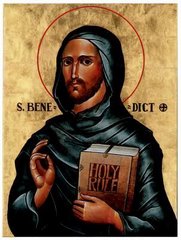giovedì 2 luglio 2009
Response to Article in Varsitarian
This is in response to the article "Bringing Back the Latin Mass" that is published in your 30 June 2009 issue where there is a statement there from Fr. Isidro Rodriguez that the Latin Mass has been used for almost 15 centuries. It must be clarified that although Latin was used since the 4th century, the rite of the Mass as celebrated from the 4th up to the 8th century, that is considered the Classical Roman Liturgy, is not the same as the Tridentine Mass. Evidence in the earliest Roman Ordines of the time indicate a participative celebration wherein the presider (priest) is intelligible to the people (Latin was lingua franca) and is in dialogue with them during the celebration, whereas the Latin Mass that is being 'revived' is the Tridentine Mass which is basically a crystallization of the various eucharistic practices as of the Council of Trent, wherein the change of focus of theology has caused the mystery of God to be solely the business of the priest. The Tridentine Rite is technically speaking only around 400 years old - that is why it's Tridentine, it is from Trent. The Mass that Traditionalists call "Novus Ordo" is much closer to the pristine rite of the fathers of the Church. Moreover, the Latin Mass during the first millenium could not claim universal use because there was no central liturgical commission before the Council of Trent and each Diocese or region would have its own form of celebration. It is a fallacy to think that the Latin Mass was used everywhere. To prove this, there exists in the Churches in communion with Rome such rich forms of worship as the Visigothic/Mozarabic Rite (Spain), Gallican Rite (France/Germany), Ambrosian Rite (Milan), which the Tridentine Rite practically wiped out. And the Eastern Church have their own Rites (Byzantine, Coptic, etc). For our liturgical and sacramental celebrations to bear fruit among the Christian faithful, it is necessary to understand the language used to glorify God and sanctify humankind. Although we cannot fully grasp the entire Mystery of God, there's nothing wrong with understanding him in a language that more people use. You should have asked a real expert. One of the former presidents of the Pontifical Institute of Liturgy in Rome is Filipino and he's now back living here in the Philippines. Fr. Anscar Chupungco OSB was former rector of San Beda and he is editor of the Handbook for Liturgical Studies, the textbook on the subject used all over the world.
Etichette:
article,
catechesis,
classical roman liturgy,
history,
liturgical studies,
tridentine
Iscriviti a:
Commenti sul post (Atom)

2 commenti:
Really Jeff? The Novus Ordo is closer to the pristine rite of the Fathers? Where in the world did you get that notion?
Paul VI himself admitted that this is an invention!
Jeff your appraisal of the "Tridentine Mass" is not true at all. You have put a bit of ideological spin in. Do not pay any attention to Fr. Anscar Chupungco OSB. The Beda was not a happy place with him there. He is a liberal modernist. Rembrandt Weakland was the Abbot General of the Benedictines and in charge of St Anselmo. Would you believe him? No! He used to boast he had the ear of Paul the VI and had destroyed the liturgy with Bugnini while they sat in Roman cafes. Do not fall for a certain outlook that is contradicted by men from Jungman to Klaus Gamber. Pope Benedict has some things to say that would knock the claim on the head that the Mass authorised at Trent was not in all essentials that of Pope Gregory the Great. I can assure you that Latin especially liturgical latin was never the spoken latin of the people. It was more formal. Also Latin was used by peoples that did not speak it in daily speech.
The Church in England for example used latin but people learnt there parts through repetition as we all do today.By the way yes there are various usages such as Sarem...if you examine the Mass structure etc you will see they all all based on the Roman Rite.
Posta un commento